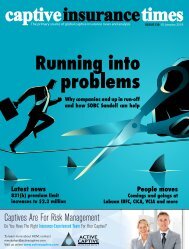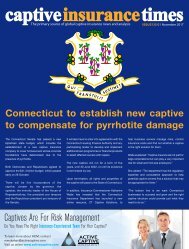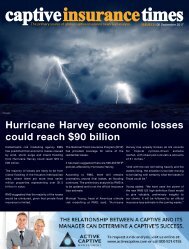Captive Insurance Times issue 138
In this issue of Captive Insurance Times, find out more on the UK’s insurance linked-securities (ILS) legislation, which was passed on 29 November. After two years in the making, a government cross-party committee approved the UK’s Risk Transformation Regulations 2017 and the Risk Transformation (Tax) Regulations 2017, which make up the UK’s ILS legislation. In other news, Bob Chaput of Clearwater Compliance discusses how healthcare systems are playing major catch-up when it comes to cybercrime. From everyone at Captive Insurance Times, we wish all of our readers a very Merry Christmas and a happy and prosperous New Year. Don't forget to visit www.captiveinsurancetimes.com to read the latest news, scan the most recent issues, or check out upcoming events.
In this issue of Captive Insurance Times, find out more on the UK’s insurance linked-securities (ILS) legislation, which was passed on 29 November.
After two years in the making, a government cross-party committee approved the UK’s Risk Transformation Regulations 2017 and the Risk Transformation (Tax) Regulations 2017, which make up the UK’s ILS legislation.
In other news, Bob Chaput of Clearwater Compliance discusses how healthcare systems are playing major catch-up when it comes to cybercrime.
From everyone at Captive Insurance Times, we wish all of our readers a very Merry Christmas and a happy and prosperous New Year.
Don't forget to visit www.captiveinsurancetimes.com to read the latest news, scan the most recent issues, or check out upcoming events.
Create successful ePaper yourself
Turn your PDF publications into a flip-book with our unique Google optimized e-Paper software.
ISSUE<strong>138</strong> 13 December 2017<br />
London tucks into a slice of the ILS pie<br />
A UK government cross-party committee<br />
has approved the UK’s Risk Transformation<br />
Regulations 2017 and the Risk<br />
Transformation (Tax) Regulations 2017,<br />
which make up the UK’s insurance linkedsecurities<br />
(ILS) legislation.<br />
In the Fifth Delegated Legislation<br />
Committee meeting, on 29 November,<br />
Jonathan Reynolds, Labour Co-operative<br />
MP and shadow economic secretary to<br />
the treasury, said: “We should always<br />
bear in mind the potential risks around<br />
securities markets, with the ILS being<br />
particularly affected during the global<br />
financial crisis.”<br />
Reynolds explained that this package of<br />
measures was announced in the 2015<br />
budget, “a long time ago” in political terms.<br />
He commented: “Now we face an entirely<br />
different landscape due to our exit from the<br />
EU. I do find it odd that the government is<br />
taking this approach to ensure the London<br />
market is equipped to compete globally,<br />
while ignoring the elephant in the room,<br />
which is that a no deal Brexit would cut off<br />
the industry at it’s knees.”<br />
However, Stephen Barclay, Conservative<br />
MP and economic secretary to the Treasury,<br />
replied to the shadow minister stating:<br />
“It is Brexit that reinforces the benefit of<br />
increasing the UK’s influence over what is<br />
already an established part of the market<br />
… one that is currently off shore. Bringing<br />
it within the UK will give UK regulators more<br />
influence over this market.”<br />
Read more on p8<br />
<strong>Captive</strong>s Are For Risk Management<br />
Do You Have The Right <strong>Insurance</strong>-Experienced Team For Your <strong>Captive</strong>?<br />
To learn more about ACM, contact<br />
mmckahan@activecaptive.com.<br />
Visit us online www.activecaptive.com
News Round-Up<br />
Bermuda Monetary Authority report<br />
reveals diverse captive industry<br />
The majority of risk assumed by Bermudabased<br />
captive insurance companies<br />
originates in North America, but business<br />
lines covered in the jurisdiction remain<br />
diverse, according to the Bermuda Monetary<br />
Authority (BMA) <strong>Captive</strong> and Special-<br />
Purpose Insurers (SPI) Report 2017.<br />
Inside<br />
According to the report, 62 percent of risk<br />
originates in North America, while 25 percent<br />
comes from Europe. Of European risk, almost<br />
half was from Ireland, and 25 percent was from<br />
the UK.<br />
The report noted that Bermuda does not<br />
focus or specialise on any particular industry<br />
or type of business underwritten. This means<br />
it has a diverse range of industries that are<br />
utilising captives for risk management.<br />
The largest industry is financial institutions,<br />
which are parent companies for 18 percent<br />
or captives.<br />
News Round-Up<br />
SOBC Sandell has completed the<br />
acquisition of American Safety RRG after<br />
receiving regulatory approval<br />
page 4<br />
Healthcare Cybercrime<br />
Healthcare systems are playing major<br />
catch-up when it comes to cybercrime,<br />
says Bob Chaput of Clearwater Compliance<br />
page 10<br />
ILS Update<br />
The UK’s insurance linked-securities<br />
legislation has been approved by a UK<br />
Government cross-party committee<br />
page 8<br />
Industry Appointments<br />
Coming and goings at the National<br />
Association of <strong>Insurance</strong> Commissioners,<br />
Compre, MEC and more<br />
page 14<br />
This is followed by the shipping, transport<br />
and storage industry with 14 percent, and<br />
the automotive, manufacturing and retail<br />
industry with 11 percent.<br />
<strong>Captive</strong>s that focus on financial institutions<br />
take a significant piece, 54 percent, of the<br />
premium share of the Bermuda captive market.<br />
Those focusing on shipping, transport and<br />
storage take 11 percent, and wholesale and<br />
retail captives take 6 percent.<br />
Of business written by Bermuda captives, 55<br />
percent falls under property coverage lines, while<br />
45 percent is casualty coverage. Of all property<br />
coverage, 38 percent is property and casualty<br />
catastrophe coverage; 21 percent is for warranty<br />
and residual value; and 16 percent was marine<br />
coverage, including protection and indemnity,<br />
cargo, hull and liability and war coverage.<br />
Casualty coverage is more evenly split, with<br />
workers’ compensation and employers’<br />
liability accounting for 29 percent; motor<br />
coverage accounting for 24 percent; and<br />
general liability, including public, products,<br />
umbrella and product recall coverage,<br />
accounting for 21 percent.<br />
In terms of market composition, the report<br />
said 61 percent of captives have a ‘pure<br />
captive’ structure. The next most common<br />
structure was ‘other’, however, selected by<br />
21 percent.<br />
MANAGING RISK WORLDWIDE<br />
DELIVERING SOLUTIONS FOR BUSINESSES AND INSURERS WORLDWIDE<br />
To find out more, please contact :<br />
Life Company Management<br />
Jeffrey More<br />
+44 1624 683602<br />
Jeffrey.More@ctplc.com<br />
<strong>Captive</strong> Management<br />
William Wood<br />
+1 441 278 7709<br />
William.Wood@ctplc.com<br />
Risk Management<br />
Chris Moss<br />
+1 972 447 2053<br />
Christopher.Moss@ctplc.com<br />
www.ctplc.com<br />
2 <strong>Captive</strong> <strong>Insurance</strong> <strong>Times</strong> www.captiveinsurancetimes.com
Protect Your Back<br />
and Your Bottom Line.<br />
Smart businesses<br />
know how to<br />
manage risk,<br />
expenses and cash<br />
flow by covering<br />
themselves with<br />
captive insurance.<br />
As the leading bank for business,* and one of the few banks with a dedicated captive<br />
team, Comerica Bank can help find the best financial solutions for your captive.<br />
Our award-winning captive insurance team has been serving the needs of captives<br />
for over 25 years in all major domiciles. We provide the banking tools and services<br />
required to effectively manage captives, from letters of credit to Regulation 114 Trusts<br />
and investment management. 1<br />
To learn more, call 313.757.5046 or visit Comerica.com/captive.<br />
RAISE YOUR EXPECTATIONS.<br />
®<br />
MEMBER FDIC. EQUAL OPPORTUNITY LENDER.<br />
*Comerica ranks first nationally among the top 25 U.S. financial holding companies, based on commercial and industrial loans outstanding as a percentage of assets, as of December 31, 2016. Data provided<br />
by SNL Financial. 1 Securities and other non-deposit investment products are not insured by the FDIC; are not deposits or other obligations of, or guaranteed by, Comerica Bank or any of its affiliates; and<br />
are subject to investment risks, including possible loss of the principal invested. Past performance is not indicative of future results.<br />
CBC-7079-03 06/17
News Round-Up<br />
Rent-a-captives account for 7 percent,<br />
while group captives, association<br />
captives and agency captives account<br />
for 6, 4 and 1 percent, respectively, and<br />
risk retention groups make up less than 1<br />
percent of the market.<br />
Around 17 percent of insurers have<br />
segregated accounts, and 15 percent are<br />
in run-off.<br />
The report also noted the success of SPIs,<br />
following the introduction of the regime in<br />
2009, suggesting it has been “the catalyst”<br />
for creation of the insurance-linked securities<br />
market in the island.<br />
Bermuda SPIs wrote coverage in 17 regions<br />
in 2016, with 69 percent of business coming<br />
from North America and 25 percent coming<br />
from Europe.<br />
SPI reinsurance covers consisted primarily<br />
of catastrophe bonds and collateralised<br />
reinsurance, accounting for 44 percent and<br />
36 percent, respectively.<br />
Over 90 percent of premiums were written<br />
for property lines of business. Of all property<br />
lines, 77 percent was property and casualty<br />
catastrophe. Terrorism coverage accounted<br />
for 15 percent.<br />
Craig Swan, managing director for supervision<br />
(insurance) at BMA, said: “Considering the<br />
island’s leadership position in the global captive<br />
and SPI space, and its overall importance,<br />
there is naturally a level of interest generated<br />
from industry participants and peers.”<br />
SOBC Sandell acquires American<br />
Safety Risk Retention Group<br />
SOBC Sandell has completed the<br />
acquisition of American Safety Risk<br />
Retention Group (RRG) after receiving<br />
regulatory approval from the Vermont<br />
Department of Financial Regulation.<br />
American Safety marks SOBC Sandell’s<br />
sixth acquisition.<br />
Stephanie Mocatta, CEO of SOBC, said: “This<br />
acquisition builds on the recent transaction in<br />
Montana and we are very pleased to be able<br />
to provide finality to RRGs in these states.<br />
SOBC Sandell has the specialist skills and<br />
understanding that enables us to purchase<br />
these groups, allowing the previous owners to<br />
exit without any future liability. We are actively<br />
looking at other opportunities to work with<br />
RRGs and captives.”<br />
Rick Ecklord, senior managing director and<br />
partner at Sandell Re, added: “We are really<br />
pleased with the growth in the group and<br />
more particularly the team’s ability to provide<br />
solutions for complex, difficult or challenging<br />
insurance situations, through the provision<br />
of innovative solutions.”<br />
R&Q completes RQMA sale with Coverys<br />
Randall & Quilter (R&Q) has completed the<br />
sale of its Lloyd’s managing agency, R&Q<br />
Managing Agency (RQMA), to Coverys.<br />
As part of the acquisition, RQMA will be<br />
renamed as Coverys Managing Agency.<br />
On completion, a cash payment by Coverys<br />
of $22.6 million will be paid to R&Q, which,<br />
after costs and related incentive payments,<br />
will result in estimated net proceeds of<br />
£13.1 million. R&Q expects to generate<br />
a gain of $11.8 million over the group’s<br />
carrying value of RQMA.<br />
The net proceeds of the sale will be<br />
deployed to help finance R&Q’s legacy<br />
transaction pipeline, especially in the US<br />
and Lloyd’s, and to generate valuable<br />
commission income from the use of Malta’s<br />
direct licenses.<br />
RQMA’s core business is the management<br />
of Syndicate 1991, which writes niche small<br />
and medium-sized enterprise property and<br />
casualty business, mostly through delegated<br />
underwriting authorities.<br />
It also manages Syndicate 3330, which<br />
provides reinsurance to close and other<br />
reinsurance solutions for legacy business<br />
within Lloyd’s.<br />
Ken Randall, R&Q chairman and CEO,<br />
commented: “We are pleased to have<br />
concluded this transaction with Coverys<br />
which is a key element of our strategy to<br />
focus on legacy acquisitions and the writing<br />
of quality program business, which is<br />
mostly reinsured to highly rated reinsurers.”<br />
Gregg L Hanson, CEO and president of<br />
Coverys, said: “Through the acquisition,<br />
Coverys will inherit the continued<br />
responsibility to support the syndicates<br />
currently under management with RQMA.<br />
Domicile Guidebook 2017<br />
Domicile Guidebook 2017<br />
A guide to traversing the captive terrain<br />
Download now from captiveinsurancetime.com<br />
A guide to traversing<br />
the captive terrain<br />
4 <strong>Captive</strong> <strong>Insurance</strong> <strong>Times</strong> www.captiveinsurancetimes.com
malta<br />
flawless structure<br />
seamless opportunities<br />
Malta is host to a myriad of captive re/insurance companies, protected cell companies and cells that have come to<br />
enjoy the domicile’s stable regulatory environment and EU membership benefits. Malta offers re/insurers and cells:<br />
European Union Membership - Malta’s status as an EU member allows companies and cells the ability to<br />
passport their services throughout the European Union and EEA states. Maltese insurance<br />
law and regulation implements all relevant EU directives.<br />
Redomiciliation Legislation - Companies established in other countries can seamlessly transfer to Malta without any<br />
break in their corporate existence.<br />
Protected Cell Legislation - Protected Cell Companies can be incorporated in Malta, enabling cell promoters to write<br />
insurance through a cell. The law ensures proper protection and insulation of cell assets and liabilities from<br />
those of other protected cells and the core of the protected cell company.<br />
A Stable Regulatory Framework - The Malta Financial Services Authority (MFSA) is reputed to be “firm but<br />
flexible” - encouraging discussion with promoters at all stages of an application process and<br />
also on an ongoing basis.<br />
Extensive Double Taxation Treaty Network - Malta has around 70 tax treaties with various EU and non EU countries.<br />
more information on:<br />
www.financemalta.org<br />
Effective | Secure | Skilled<br />
Find us on: FinanceMalta<br />
@FinanceMalta FinanceMaltaYT FinanceMalta<br />
FinanceMalta - Garrison Chapel, Castille Place, Valletta VLT1063 - Malta | info@financemalta.org | tel. +356 2122 4525 | fax. +356 2144 9212<br />
FinanceMalta is the public-private initiative set up to promote Malta’s International Financial Centre
News Round-Up<br />
The acquisition additionally allows Coverys<br />
to assist new underwriting syndicates that<br />
seek to launch their business at Lloyd’s,<br />
while also maintaining business operations<br />
for existing syndicates.”<br />
ERI Re receives ‘good’ ratings<br />
A.M. Best has assigned a financial strength<br />
rating of “B+ (Good)”, and a long-term <strong>issue</strong>r<br />
credit rating of “bbb-” to Barbados reinsurer<br />
Energy Risk Indemnity Reinsurance (ERI Re).<br />
ERI Re is a Barbados-based start-up<br />
reinsurer, originally established in 2013 as<br />
a segregated cell company (SCC) focused<br />
in energy risks.<br />
Between 2013 and 2015, ERI Re conducted<br />
business as an SCC, however, in 2016<br />
management changed its license to a<br />
qualify as an insurance company to diversify<br />
its book of business and to underwrite a<br />
broader range of risks in the Latin American<br />
property and casualty market.<br />
The ratings of ERI Re reflect its strong<br />
capital base for the purpose of developing<br />
a diversified property and casualty book of<br />
business throughout Latin America.<br />
According to A.M. Best, the business plan<br />
of the company is “well structured”, but<br />
is dependent on reinsurance, a key factor<br />
considering the expositions the company<br />
wants to take geographically in Latin America.<br />
The ratings agency explained that the<br />
property and casualty lines it is targeting,<br />
such as bonds, property, oil and mining,<br />
require strong reinsurance protection.<br />
ERI Re is currently structuring its reinsurance<br />
programme and will remain a key factor for<br />
future rating assessments.<br />
A.M. Best said: “While the company is<br />
targeting reasonable premium volumes,<br />
due to the start-up nature of the company,<br />
execution risk limits the ratings; nevertheless,<br />
the company has a strong management and<br />
underwriting team to execute its business<br />
plan and to develop the company’s risk<br />
capabilities as its business grows.”<br />
It added: “Positive rating actions could take<br />
place if the company is able to achieve its<br />
goals in terms of premium volume and<br />
profitability while maintaining a strong riskadjusted<br />
capitalisation. Negative rating<br />
actions could take place if the company fails<br />
to meet its financial performance to a level<br />
that impacts its capital and therefore its riskadjusted<br />
capitalisation.”<br />
VADA to use CHSI Technologies<br />
Virginia Automobile Dealers Association<br />
(VADA) Group Self-<strong>Insurance</strong> Association<br />
(GSIA) is set to implement the CHSI<br />
Technologies cloud-based suite of<br />
configurable core systems software.<br />
VADA GSIA provides its members with<br />
effective workers’ compensation coverage.<br />
According to Michael Allen, general<br />
Excellence in <strong>Insurance</strong> Asset Management<br />
Enterprise Risk Management<br />
focused solutions<br />
Fixed income, equity and<br />
alternatives expertise<br />
Direct interface with portfolio<br />
managers<br />
Regulatory and A.M. Best reporting<br />
and support<br />
24/7 online investment and<br />
statutory accounting<br />
Comprehensive<br />
investment<br />
solutions<br />
customized to<br />
fit your needs.<br />
800-767-8020 | 480-596-3338<br />
info@madisonascottsdale.com | madisonscottsdale.com<br />
Madison Scottsdale is the insurance asset management division of Madison Investment Advisors, LLC.<br />
6 <strong>Captive</strong> <strong>Insurance</strong> <strong>Times</strong> www.captiveinsurancetimes.com
News Round-Up<br />
manager of VADA GSIA, the implementation<br />
is part of a larger plan to take all six of VADA’s<br />
operations to the cloud.<br />
Allen said: “Like a lot of self-insured groups,<br />
we’ve had a policy administration server in<br />
place for more than 25 years, and CHSI’s<br />
offering of their configurable core systems<br />
modules via Microsoft’s Azure cloud<br />
platform will help us realise our larger plan.”<br />
“The [workers’ compensation] formula is the<br />
formula, so our goal is to become as efficient<br />
as possible in order to offer competitive<br />
pricing and cutting-edge claims and loss<br />
control services. To do that we need to get<br />
off the server and move to modern systems<br />
that run in the cloud.”<br />
Beijing and Guernsey partner up on<br />
captive insurance venture<br />
Beijing Airport <strong>Captive</strong> Management Consulting<br />
(BACM) and Guernsey-based insurance<br />
manager Alternative Risk Management<br />
(ARM) have partnered up on captive<br />
insurance project for Chinese businesses.<br />
As part of the joint venture, ARM will work<br />
alongside BACM to create a series of captive<br />
structures and the provision of captive<br />
management services for Chinese businesses.<br />
Currently, BACM is the only captive insurance<br />
consulting group in China and is backed<br />
by the Beijing Airport Economic Core Zone<br />
(BAECZ), a key hub for China’s business,<br />
industrial and creative sectors.<br />
In March, Guernsey Finance signed a<br />
memorandum of understanding with the<br />
BAECZ on behalf of Guernsey’s finance sector.<br />
According to Charles Scott, managing<br />
director of ARM, captives are going to be<br />
at the forefront of innovation in China’s<br />
insurance market.<br />
Scott said: “Chinese companies with<br />
international operations and those looking<br />
at expanding overseas are considering<br />
ways to use captive vehicles for their risk<br />
management needs rather than having to<br />
insure through the commercial market.”<br />
He added: “It is therefore an opportune<br />
time to have established a key partnership<br />
on the ground in Beijing. The fact that<br />
Guernsey Finance signed an memorandum<br />
of understanding with the BAECZ in March<br />
really facilitated our own agreement.”<br />
Last week, Guernsey Finance announced<br />
the establishment of Brilliant Reinsurance,<br />
the island’s first Chinese insurance company.<br />
Managed and established by ARM, the<br />
insurance company will focus on business<br />
being retroceded from the Lloyd’s of<br />
London market.<br />
Do you have a story we should cover?<br />
Let us know via:<br />
beckybutcher@blackknightmedialtd.com<br />
www.captiveinsurancetimes.com<br />
<strong>Captive</strong> <strong>Insurance</strong> <strong>Times</strong><br />
7
ILS Update<br />
The ILS pie<br />
Over the past two years, the UK Treasury has worked with the<br />
Prudential Regulation Authority (PRA), the Financial Conduct<br />
Authority (FCA) and the London Market Group’s ILS taskforce to<br />
develop a “fit-for-purpose” ILS framework for the UK.<br />
Nicolas Aubert, chairman of the London Market Group, said:<br />
“Looking back at where we started in April 2015, our original<br />
wish list has pretty much been delivered in full and we appreciate<br />
the support that we have received from HM Treasury, the PRA<br />
and the FCA.”<br />
He said: “Each cell is fully funded for the risk or portfolio of risks<br />
for which it is designed, but is isolated from other cells within the<br />
PCC, ensuring there is no cross-contamination.”<br />
ILS has been gaining popularity over the last two decades and<br />
growth is set to continue.<br />
He added: “The strength of London’s reputation will serve as an<br />
advantage given recent disclosures around offshore tax havens,<br />
some of which have already become established ILS centres.” CIT<br />
Malcolm Newman, chairman of LMG’s ILS Taskforce, added:<br />
“Undoubtedly the regulations will evolve over time as the<br />
ILS market itself evolves, and we are encouraged by the<br />
PRA’s willingness to engage in pre-application dialogue<br />
with parties interested in using the new regulations. This<br />
dialogue should minimise any <strong>issue</strong>s applicants may have<br />
with the regulations.”<br />
“The taskforce has consistently said that it seeks to grow the ILS<br />
pie … As an industry we need to be more vocal about the social<br />
good of insurance, demonstrating the resilience and critical<br />
support an insurance policy gives to its holder in the event of a<br />
disaster. Through doing this the pie will grow and there will be<br />
opportunities for London market players to generate growth via<br />
both traditional cover and new ILS solutions.”<br />
ILS timeline<br />
• At the March 2015 budget, the government revealed<br />
that it would work with the insurance industry and<br />
the UK’s regulators to develop a new “competitive”<br />
corporate structure and tax regime allowing ILS<br />
vehicles to be domiciled in the UK.<br />
• A year later on 1 March 2016, the first public<br />
consultation was launched on the government’s<br />
approach to the authorisation and supervision,<br />
corporate structure and taxation of ILS vehicles in<br />
the UK.<br />
The new regulations allow for insurance and reinsurance firms<br />
to transfer risk to the capital markets, meaning that risk can be<br />
managed more effectively for businesses and consumers.<br />
According to William Hogarth, legal director at Clyde & Co, this is<br />
a “great step forward” for the UK’s insurance market.<br />
Hogarth noted that London is in a “strong position” when it<br />
comes to attracting ILS business as it is home to some of the<br />
“world’s best and brightest insurance talent”.<br />
Following the government’s initial consultation on ILS, the second<br />
consultation, published in November last year, proposed to create<br />
a protected cell company (PCC) regime for multi-arrangement<br />
insurance special purpose vehicles (ISPVs).<br />
Hogarth suggested that the PCC model for ILS is attractive<br />
because it allows investors to “ring-fence risk; with each<br />
individual cell of a PCC effectively operating like a separate<br />
insurance vehicle”.<br />
• A second consultation was then launched later in<br />
November 2016.<br />
• The introduction of ILS legislation was delayed after<br />
UK Prime Minister Theresa May called for the snap<br />
general election that was held on 8 June. A final<br />
version of the UK’s ILS framework was expected<br />
to be published Spring 2017, but May’s decision to<br />
call a general election delayed the process.<br />
• The UK Treasury published new rules for ILS in July<br />
this year.<br />
• On 29 November, a Delegated Legislation<br />
Committee in Parliament approved the UK’s Risk<br />
Transformation Regulations 2017 and the Risk<br />
Transformation (Tax) Regulations 2017, which make<br />
up the UK’s ILS regulation.<br />
8 <strong>Captive</strong> <strong>Insurance</strong> <strong>Times</strong> www.captiveinsurancetimes.com
RISK IS<br />
EVERYWHERE.<br />
IT TAKES VISION<br />
In today’s world, complacency has<br />
a cost. Unforeseen risks can even<br />
bring down a company. To go beyond<br />
oversight and bring insight, rely on one<br />
of the global leaders in actuarial and<br />
risk consulting. Because the status<br />
quo really isn’t an option. To learn<br />
more, visit milliman.com/captives.
Becky Butcher reports<br />
Healthcare Cybercrime<br />
Playing catch-up<br />
Healthcare systems are playing major catch-up when it comes to<br />
cybercrime. Bob Chaput of Clearwater Compliance explains more<br />
Are hospitals and healthcare systems doing enough<br />
to protect against cyber attacks and cyber threats?<br />
The punch line is this: hospitals and healthcare systems are<br />
playing major catch-up. Incentive moneys to digitise healthcare<br />
has taken priority. Historically, we have been years behind other<br />
industries in the adoption of technology, and when it comes<br />
to safeguarding healthcare information, a decade behind. In<br />
addition, hospitals traditionally view cyber risk management as an<br />
<strong>issue</strong> for their information technology professionals to manage.<br />
What we are seeing is the perfect storm emerging. Patient health<br />
is extremely vulnerable. The changing threat environment and<br />
the internet of things (IoT) is blurring lines between information<br />
security and patient safety and is requiring each discipline to<br />
expand its scope.<br />
Healthcare leaders need to gain greater visibility into what’s<br />
happening enterprise-wide as it relates to IoT devices and<br />
proactively monitor threats across the organisation. It’s not only<br />
about the traditional IT assets such as the electronic health<br />
10 <strong>Captive</strong> <strong>Insurance</strong> <strong>Times</strong> www.captiveinsurancetimes.com
Healthcare Cybercrime<br />
record system and the pharmacy and radiology systems, it’s also<br />
about biomedical devices that are attached to our patients or<br />
implanted in them. We see this as a large and growing business<br />
risk management <strong>issue</strong>, around which healthcare could be doing<br />
a whole lot more.<br />
Medical devices today can be used in the home, across<br />
networks in hospitals, and embedded in the patient. However,<br />
many IoT-enabled medical devices were manufactured without<br />
understanding the full implications of cybersecurity. IoT-enabled<br />
medical devices can expose people, hospitals, and manufacturers<br />
to many significant risks. These risks include possible harm to a<br />
patient’s safety and health, loss of Protected Health Information<br />
(PHI), disruption of information flow of connected devices,<br />
physical interference with equipment, impact on business<br />
operations, damage to critical infrastructure, and unauthorised<br />
access to devices. Within hospitals, these devices enter through<br />
numerous channels. Any threats to the confidentiality, integrity,<br />
or availability of information represent threats to patient safety.<br />
Identifying and mitigating potential risks in legacy and connected<br />
devices is an important challenge for the industry. Many<br />
organisations are starting to take action on the cybersecurity and<br />
privacy fronts.<br />
Hospital and healthcare systems in particular are playing major<br />
catch-up as it relates to cyber attacks, and there are opportunities<br />
for improvement. What we’ve had in the US as a result of the<br />
Electronic Health Records (EHR) incentive monies that have been<br />
awarded by the government through the 2009 American Recovery<br />
and Reinvestment Act (ARRA) is a great digitisation of our health<br />
care system. This significant investment in digitising healthcare<br />
has really taken priority over the matter of safeguarding it.<br />
Is technology moving too fast for health systems to<br />
keep up?<br />
There’s no doubt that the evolving pace of technology is moving<br />
too fast for the healthcare industry, but traditional approaches to<br />
patient safety and healthcare information risk management need<br />
to run alongside and evolve to address today’s technology and<br />
emerging direct threats to patients.<br />
The fast change of technology opens the door to a wide spectrum<br />
of threats, ranging from traditional intrusions designed to steal<br />
PHI to more novel attacks, such as tampering with biomedical<br />
devices or blocking access to essential records systems.<br />
Information security has become an essential component of<br />
patient safety. Concurrently, the information needed to provide<br />
care resides in more places than ever before, including electronic<br />
health records; the smartphones, tablets and laptops carried by<br />
physicians and other caregivers; intelligent medical devices such<br />
as smart pumps, monitors and implants; patient portals; and<br />
mobile health apps, not to mention provider partners, business<br />
associates and other members of the patient care ecosystem.<br />
Safe, quality care depends on timely access to this information.<br />
Therefore, any threats to the confidentiality, integrity or availability<br />
of information represent threats to patient safety.<br />
In large hospitals or health systems, departmental heads have a<br />
fair amount of autonomy over their selection and deployment of<br />
technology, and there are risk consequences. The IT person who<br />
is responsible for the networking and computing, applications<br />
and infrastructure is often unaware as new devices are attached<br />
to his or her networks. It’s a challenging problem for CIOs.<br />
Hospital and Health System CIOs and Chief Information Security<br />
Officers (CISOs) must collaborate with peers to integrate their<br />
cyber or information risk management (IRM) strategy into their<br />
organisation’s overall enterprise risk management/governance,<br />
risk managament and compliance strategy. Both must become<br />
part of day-to-day operations and address the requirement<br />
to respond to inevitable cyber incidents and restore normal<br />
operations. When hospital leaders adopt an integrated IRM/<br />
ERM strategy, there can be greater returns for the organisation<br />
in terms of expanded knowledge, informed decision-making and<br />
reduced cyber risk. But, when they choose to ignore the strategic<br />
importance of IRM, the resulting complaints, breaches, failed<br />
audits or cyberattacks can erode the confidence of patients and<br />
staff, limiting the organisation’s ability to grow.<br />
With so many areas to protect, how do hospitals<br />
and healthcare systems go about understanding<br />
cyber exposures?<br />
First and foremost, hospitals need to do a better job of<br />
understanding their exposures. Hospitals and healthcare systems<br />
should be encouraged to look at the expanded ecosystem of the<br />
healthcare organisation and conduct a comprehensive information<br />
risk management (IRM) approach that is not a checklist. It’s a<br />
fundamental matter of identifying exposures and understanding<br />
them better. Understanding cyber exposures, it’s the starting point.<br />
How have hospitals and healthcare systems become<br />
big targets for cyber attacks? What threats are they<br />
actually facing?<br />
What better place is there for a bad guy to look than in health<br />
care—it’s single biggest hub for data. It’s a veritable library of our<br />
personal information and a treasure trove of that information. Not<br />
only do we have electronically protected health information, we<br />
have other personal identifiable information that includes driver’s<br />
licenses, dates of birth and, probably, payment card data.<br />
The types of cyber threats and attacks that organisations are<br />
facing include these four categories—adversarial, accidental,<br />
structural and environmental. In doing a risk analysis, these are<br />
the four categories that are evaluated.<br />
Of those four categories, the cyber attacker falls into adversarial.<br />
Organisations have threats in the adversarial category other than<br />
www.captiveinsurancetimes.com<br />
<strong>Captive</strong> <strong>Insurance</strong> <strong>Times</strong><br />
11
Healthcare Cybercrime<br />
foreign nations. It might be a malicious insider, and that individual<br />
may be the person who’s siphoning and infiltrating all kinds of<br />
data from the organisation.<br />
The accidental cyber threat can be in or outside the organisation.<br />
It can be as simple as a backhoe operator digging up a fiber<br />
optic cable that could disconnect your hospital from its electronic<br />
health record system.<br />
of that, you may be overspending or you may be woefully underprotecting<br />
your information assets. So you need to be wary of<br />
control checklists.<br />
Checklists will tell you to implement encryption, a firewall, data<br />
leak protection, a strong malware system and a good training<br />
programme, but if you have limited resources, how do you<br />
know in what order you should implement those? You will only<br />
understand that when you know your exposures.<br />
Structural threats are subject to the laws of physics; we’re dealing<br />
with electro-mechanical devices there.<br />
Environmental risks have to do with fires, earthquakes, mudslides<br />
and hurricanes. Health care can fall victim to these natural disasters.<br />
How can a captive help solve the problem?<br />
It’s about revenue and reputation and regulation … what we are<br />
seeing is that privacy/cyber risk is bleeding into professional<br />
liability <strong>issue</strong>s.<br />
In your opinion, what is the safest way to safeguard<br />
patients’ healthcare?<br />
First step is to conduct comprehensive risk identification and<br />
assessment. The second step is to build a programme—not a<br />
once-and-done programme—but to adopt a cyber security<br />
framework, formal process and maturity model mentality;<br />
establishing, implementing, and maturing a programme.<br />
The only way you can do this is if you understand what your<br />
exposures are. The most effective way is at a very operational<br />
level, by adopting a comprehensive, accurate risk analysis. This<br />
way you will gain a better understanding of your exposures and<br />
be able to address importance compliance.<br />
Building a programme that adopts a cyber security framework,<br />
adopting a process and maturity model mentality, is showing<br />
continuous process improvement. This work needs to turn into<br />
establishing, implementing and maturing the programme.<br />
Hospitals must be very wary of a “control checklist”. Controls<br />
are a guide and source of actions you might take when, and only<br />
when, you understand what your exposures are. In the absence<br />
A captive structure can be the keystone to a healthcare<br />
organisation’s risk management strategy. <strong>Captive</strong>s have long<br />
been a haven for funds used to finance risk.<br />
But, difficulties in measuring cyber exposures and concerns over<br />
the size of the exposure are still holding many captive owners back.<br />
Rather than securing funding to address the after-effects of a cyber<br />
attack, organisations should understand how a captive can be used<br />
to provide grants to the captive owner for reducing cyber risk and<br />
improving patient safety through training, periodic risk analyses and<br />
compliance assessments.<br />
Do you think there should be more regulation in terms<br />
of cyber security for healthcare to make sure these<br />
big organisations understand their cyber exposures?<br />
I’m not a fan of more regulation. The <strong>issue</strong> here is enforcing the<br />
regulations that already exist, implementing more accountability.<br />
If anything, I would tweak the regulations around accountability.<br />
The mantra of health care is “first, do no harm”. All we need to<br />
do is move this newly created matter of creating harm onto the<br />
agenda of those people who have, naturally and historically, been<br />
risk managers. CIT<br />
A captive structure can be the<br />
keystone to a healthcare organisation’s<br />
risk management strategy. <strong>Captive</strong>s have<br />
long been a haven for funds used to<br />
finance risk<br />
Bob Chaput, CEO and founder, Clearwater Compliance<br />
12 <strong>Captive</strong> <strong>Insurance</strong> <strong>Times</strong> www.captiveinsurancetimes.com
<strong>Captive</strong>s Are For<br />
Risk Management<br />
Do You Have The Right <strong>Insurance</strong>-Experienced Team For Your <strong>Captive</strong>?<br />
To learn more about ACM, contact<br />
mmckahan@activecaptive.com.<br />
Visit us online www.activecaptive.com
Industry Appointments<br />
Comings and goings at the NAIC, Compre, MEC and more<br />
Members of the National Association of <strong>Insurance</strong> Commissioners<br />
(NAIC) have elected the association’s 2018 officers.<br />
Ito is new to the leadership of the NAIC, but previously served as<br />
chair of its Western zone.<br />
The appointments were made at the NAIC Fall 2017 National<br />
Meeting. All roles are effective 1 January 2018.<br />
Tennessee insurance commissioner, Julie Mix McPeak, was<br />
elected president, while Maine <strong>Insurance</strong> superintendent, Eric<br />
Cioppa, was named president-elect.<br />
Nick Steer, a founding director of Compre, will step down<br />
from his role as CEO, but will remain within the group<br />
serving as non-executive deputy chairman.<br />
As part of his new role, effective March 2018, Steer will advise on<br />
future acquisition.<br />
South Carolina insurance director Raymond Farmer will become<br />
vice president, and Hawaii insurance commissioner Gordon Ito<br />
was elected secretary-treasurer.<br />
In May, Farmer was appointed secretary-treasurer of the NAIC<br />
after the death of David Mattax in April.<br />
Will Bridger, managing director of acquisitions and Mark Lawson,<br />
group actuarial director, will jointly take on the role as co-CEOs.<br />
Philipp Kleyser will also be appointed to the company’s German<br />
office, serving as a director of its reinsurance subsidiary, Hamburger<br />
Internationale Rückversicherung-AG.<br />
14 <strong>Captive</strong> <strong>Insurance</strong> <strong>Times</strong> www.captiveinsurancetimes.com
Industry Appointments<br />
Kleyser, who starts on 1 January 2018, joins from EY where, as<br />
executive director, he provided transaction and restructuring<br />
advisory support for the insurance industry in Germany and Europe.<br />
Steer said: “Next March I will have been with the business for<br />
32 years and CEO for the last nine. During that time, the group<br />
has completed 11 company and 27 portfolio acquisitions in 11<br />
different countries across Europe.”<br />
“It has grown to be a well-respected and trusted acquirer of nonlife<br />
insurance and reinsurance legacy business.”<br />
“I feel now is the right time to step back as CEO and let the<br />
team, under new leadership, build on the very stable platform and<br />
take the business forward. I look forward to contributing to the<br />
continued success of the business in my new role.”<br />
Midwest Employers Casualty (MEC) has appointed Greg Agnone<br />
as director of business development for group captives.<br />
In the newly-created role, he will be responsible for identifying<br />
new captive opportunities for MEC.<br />
Agnone has more than 30 years of experience in the insurance<br />
industry, and has worked in captives since 2004.<br />
MEC is a Berkley company focusing on excess workers’ comp.<br />
Capstone Associated Services has expanded its presence<br />
into the southwestern region of the US, with the addition<br />
of Clete Thompson.<br />
Thompson will return to Capstone as vice president of business<br />
development, after previously working at the company from 2007<br />
to 2014.<br />
Stewart Feldman, CEO at Capstone, said: “Clete Thomspon has<br />
deep knowledge of the captive insurance industry, and a keen<br />
ability to establish lasting business relationships—qualities that<br />
bolster Capstone’s existing multidisciplinary team.”<br />
Atlas <strong>Insurance</strong> Management has appointed Gail Olsen as<br />
senior vice president of finance and compliance.<br />
Olsen, based in the company’s Charlotte office, will be<br />
responsible for streamlining processes and reporting to improve<br />
efficiency, financial performance and profitability, creating an<br />
effective employee development programme, and developing<br />
the risk management and compliance programme.<br />
Martin Eveleigh, chairman of Atlas <strong>Insurance</strong> Management,<br />
commented: “Gail Olsen’s prior experience makes her a valuable<br />
asset to Atlas who will help us reach our internal financial and<br />
operational goals while helping our team provide solutions and<br />
great service to our clients.” CIT<br />
Acting Editor: Stephanie Palmer-Derrien<br />
stephaniepalmer@blackknightmedialtd.com<br />
+44 (0)203 750 6019<br />
Deputy Editor: Becky Butcher<br />
beckybutcher@blackknightmedialtd.com<br />
+44 (0)203 750 6019<br />
Junior Reporter: Ned Holmes<br />
nedholmes@blackknightmedialtd.com<br />
+44 (0)203 750 6022<br />
Editorial Assistant: Jenna Lomax<br />
jennalomax@blackknightmedialtd.com<br />
+44 (0) 203 750 6018<br />
Associate Publisher/Designer: John Savage<br />
johnsavage@captiveinsurancetimes.com<br />
+44 (0)203 750 6021<br />
Publisher: Justin Lawson<br />
justinlawson@captiveinsurancetimes.com<br />
+44 (0)203 750 6028<br />
Marketing Director: Steven Lafferty<br />
design@securitieslendingtimes.com<br />
+44 (0)203 750 6021<br />
Office Manager: Chelsea Bowles<br />
accounts@securitieslendingtimes.com<br />
+44 (0)203 750 6020<br />
Published by Black Knight Media Ltd<br />
Black Knight Media Ltd<br />
Provident House<br />
6-20 Burrell Row<br />
Beckenham<br />
BR3 1AT, UK<br />
Company reg: 0719464<br />
Copyright © 2017 Black Knight Media Ltd<br />
All rights reserved<br />
Stay connected with <strong>Captive</strong> <strong>Insurance</strong> <strong>Times</strong> on Twitter,<br />
Facebook and LinkedIn<br />
www.captiveinsurancetimes.com<br />
16 <strong>Captive</strong> <strong>Insurance</strong> <strong>Times</strong> www.captiveinsurancetimes.com
JANUARY 31 - FEBRUARY 2, 2018<br />
FORT LAUDERDALE MARRIOTT HARBOR<br />
BEACH RESORT & SPA, FLORIDA<br />
Celebrating its 27 TH year, the 2018 World <strong>Captive</strong> Forum will address new and emerging<br />
risks facing companies and organizations worldwide, demonstrating how captives can offer<br />
solutions that may not be available in the traditional insurance marketplace. A domicileneutral<br />
conference, the World <strong>Captive</strong> Forum provides in-depth, high-caliber educational<br />
content to risk managers, benefit managers and financial executives whose organizations<br />
have risks insured by a captive or who are exploring the formation of one. Educational<br />
content will be presented on three separate tracks: General, Property/Casualty and Benefits.<br />
SESSION HIGHLIGHTS:<br />
• <strong>Captive</strong>s 201: The Fundamentals and Recent Developments<br />
(Pre-conference Workshop)<br />
• Brexit, BEPS and Other International Regulations<br />
• Global Employee Benefit Programs: Are They Still Worth It?<br />
• Medical Stop-Loss: Structuring the Risks<br />
• Pooling in Microcaptives<br />
• Reinsurance in the Aftermath: Impact of 2017 Storms and Quakes<br />
• Growing Your <strong>Captive</strong> with Voluntary Benefits<br />
• Multiple <strong>Captive</strong>s — Why and How?<br />
• Cell Company Overview and Innovative Applications<br />
• The World of RRGs (Risk Retention Groups)<br />
SPONSORS<br />
DIAMOND<br />
PLATINUM<br />
Delaware<br />
Bureau of <strong>Captive</strong><br />
and Financial<br />
<strong>Insurance</strong> Products<br />
GOLD<br />
OPENING KEYNOTE<br />
SPACE WEATHER: ITS IMPACT<br />
ON OUR TECHNOLOGICAL WORLD<br />
Dr. C. Alex Young<br />
NASA Heliophysicist<br />
SILVER<br />
SPONSORSHIP INFORMATION<br />
Jeremy Campbell | jcampbell@businessinsurance.com | 513-737-4063<br />
REGISTER, VIEW FULL AGENDA & MORE:<br />
businessinsurance.com/conference/wcf

















